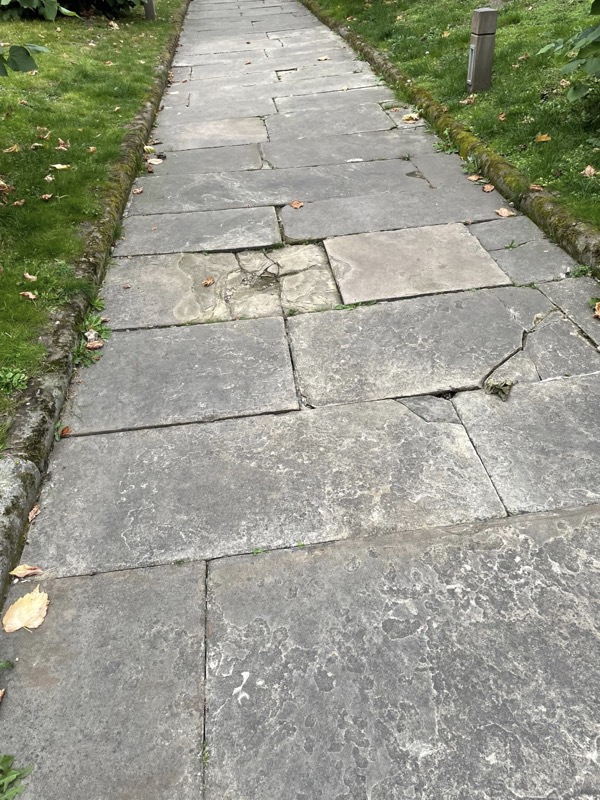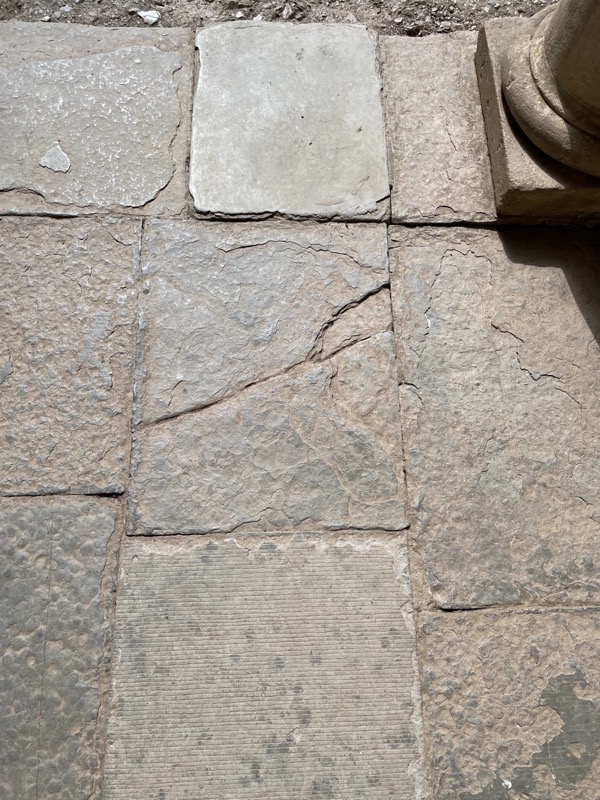Over the last 20 years, Natural Stone and Timber has been trading. On a few occasions we have had calls from customers with cracked paving slabs, they tend to first blame the product, saying that it is faulty. However, I can assure everyone reading this article that in every case we have dealt with, the cracked slabs are never the fault of the paving material used. It completely lies with the installation of the sub-base supporting the slabs. If your base is completely stable, you are able to lay any product that we supply without the possibility of cracking. As soon as you start to get movement in the sub-base, whatever the paving material is, that has been used, eventually you will start to see cracks appear. In the below article, I will address some of the most common causes of cracked paving slabs.
Unsupported slabs
Never lay paving on dots and dabs of mortar also known as the five-spot method. This will leave voids under the paving slabs which will collect water and through the freezing and thawing cycle this allows the possibility of discolouration of the slabs and in some cases, the slabs can become loose and eventually crack. These voids will also leave large areas of each slab unsupported which can result in damage if heavy loads are moved across these areas, as they would not have adequate strength to take the increased weight.
We always recommend bedding all-natural stone paving slabs on a solid mortar bed made with a maximum of 4 parts sharp sand / grit to 1 part cement. But you should always try to match the strength of the bed to the density of the slabs you are installing. This full bed method will eliminate the possibility of the slabs moving after installation from adverse weather conditions and will also provide a sufficiently strong base to take all normal day-to-day usage.
Ground settlement
This is the most common cause of visible cracks appearing on paving slabs, If the sub-base is not sufficient in depth for the ground conditions (clay soils will require greater depth of sub-base and say chalky well drained ground) or this sub-base is inadequately compacted before the paving slabs are laid. Both of these issues will result in eventual settlement of the ground, resulting in movement of the paving material and raising the possibility of them cracking. These issues are down to an inadequate understanding of the ground condition or just poor workmanship. A sufficient sub-base must be installed that will cope with the ground conditions present on the site and to cope with the load it is designed to take. This problem also occurs even if a solid concrete base has been installed over unstable ground, over a period of years the loose ground below the concrete will settle, eventually resulting in the movement of the concrete base and the slabs laid on top.

The above photo is a good example of ground settlement eventually cracking even thick Yorkstone paving slabs.
Ground shrinkage
In very dry conditions it is possible that the ground under your patio and sub-base can shrink, causing settling. This settling is generally uneven in its distribution and can cause all or just some area of the patio above to become unstable resulting in movement of the slabs and eventual cracking. This is more common in clay soils where they have a tendency to shrink to a greater extent than most other soil types. It is the responsibility of the contractor undertaking the paving work to determine the soil conditions and provide a sufficient base to overcome these potential problems.

The above images show some beautiful York stone paving laid over 100 years ago in one of the Temples at Hestercombe House, a garden design by the great partnership of Gertrude Jekyll and Sir Edward Lutyens. Over time the ground has settled naturally, and cracks have started to appear, it’s just unavoidable over the long term, even with the best preparation
Ground heave
This is basically the opposite of the above ground shrinkage but occurs on the same soil types and has the same end result. Ground heave generally occurs when clay soil starts to take on large amounts of water, this results in the ground expanding and then pushing the ground upwards lifting the patio slabs resulting in an unstable surface and resulting in cracked slabs and an unusable patio. The only way to prevent your patio from being affected by ground heave is to prepare the correct base, it would be recommended that a solid concrete base be installed over completely stable ground to prevent the paving slabs from being affected by the effects of ground heave.
Walking on too early
Another possible cause of slab movement and eventual cracking can be if the patio was walked on before it had a chance to dry properly. If an unknowing customer walks out on their lovely new patio just after the contractors have gone home, the sub-base will sink under the weight of the footsteps and will then set hard overnight in the incorrect position. This can mean the slabs are not correctly adhered to the sub-base resulting in movement and eventual cracking. Always allow at least 24 hours between installation and first use and in winter months when drying times will be extended, additional time will be needed to allow the sub-base to fully harden.
Thin porcelain paving slabs
In recent years, poor quality porcelain paving slabs have been imported from India at a depth of 16mm, these slabs are extremely fragile and not really suitable for outdoor installations. These are not products that we have ever sold ourselves, but recently we have been hearing of some problems with them not being able to cope with normal garden activity. Inevitably, even with very careful installation there will be some small voids under your paving slabs, and that is why we sell all of our porcelain paving at a depth of 20mm. These products can bridge these small voids easily, resulting in a durable finished surface that will last for many years. However, the 16mm slabs do not seem to have adequate strength to bridge these small voids and do not offer a successful long-term installation and in many cases have resulted in cracked unsightly patios.

